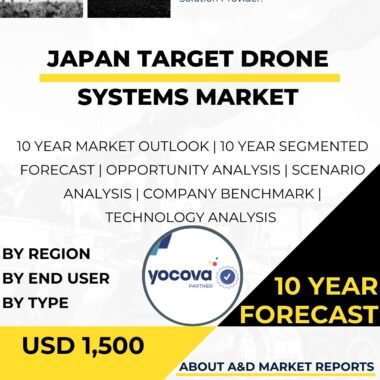Description
The South Korea target drone systems market is an important and rapidly growing segment of the country’s defense industry, providing advanced unmanned aerial vehicles (UAVs) that simulate enemy targets to enhance military training and weapon testing. Target drones, also known as aerial targets or drone targets, serve as crucial assets for evaluating and enhancing the performance of weapon systems, anti-aircraft defenses, and air-to-air missiles. South Korea’s focus on indigenous development, strategic partnerships, and technological innovation has positioned it as a notable player in the global target drone systems market.
Target drone systems play a pivotal role in modern military training and evaluation, providing realistic and cost-effective means to test and validate weapon systems’ effectiveness. These drones mimic enemy aircraft and other threats, enabling the armed forces to conduct realistic training scenarios and assess the accuracy and reliability of their weapon systems.
Indigenous development has been a cornerstone of South Korea’s approach to the target drone systems market. The country’s defense industry, represented by companies like LIG Nex1 and Hanwha Systems, has made significant strides in developing advanced target drone systems tailored to meet the specific requirements of the South Korean military.
The South Korean military relies heavily on target drone systems to improve combat readiness and enhance the proficiency of its air defense units and air-to-air missile operators. These systems provide realistic training scenarios, enabling forces to practice engaging dynamic aerial threats and fine-tune their response strategies.
Beyond defense applications, target drone systems also have civilian uses in South Korea. The country’s aerospace and defense companies develop civilian UAVs for various applications, such as aerial photography, agricultural monitoring, and environmental research.
South Korea’s commitment to innovation and research and development (R&D) has driven significant advancements in target drone technology. The country invests in R&D programs to improve drone performance, flight endurance, and target simulation capabilities. Technological improvements focus on enhancing drone maneuverability, survivability, and electronic countermeasures resistance.
Strategic partnerships with international defense and technology companies have also contributed to South Korea’s target drone capabilities. Collaborations enable technology transfer, joint research, and the integration of foreign drone systems into South Korea’s indigenous platforms, enriching the overall target drone capabilities of the country’s defense industry.
To ensure optimal utilization and proficiency in operating target drone systems, South Korea places significant emphasis on training and skill development for its military personnel. Training programs focus on familiarizing operators with drone controls, target simulation, and effective utilization in various training scenarios.
Moreover, safety and reliability are paramount considerations in the target drone systems market, given the importance of ensuring the safe operation of drones and minimizing the risk of accidents during training exercises. South Korea adheres to stringent safety protocols and drone maintenance standards to guarantee the reliability and performance of target drones, ensuring the safety of personnel and assets during training activities.
In conclusion, the South Korea target drone systems market is a critical aspect of the country’s defense capabilities. Indigenous development, strategic partnerships, and innovation have allowed South Korea to create advanced target drone systems that meet the specific needs of its military and contribute to enhancing its combat readiness. From improving air defense capabilities to conducting realistic training exercises, target drone systems play a pivotal role in strengthening South Korea’s defense and preparing its armed forces to face potential threats. As the defense industry continues to evolve, South Korea’s dedication to advancing its target drone technology will remain essential in maintaining its position as a major player in the global target drone systems market.




